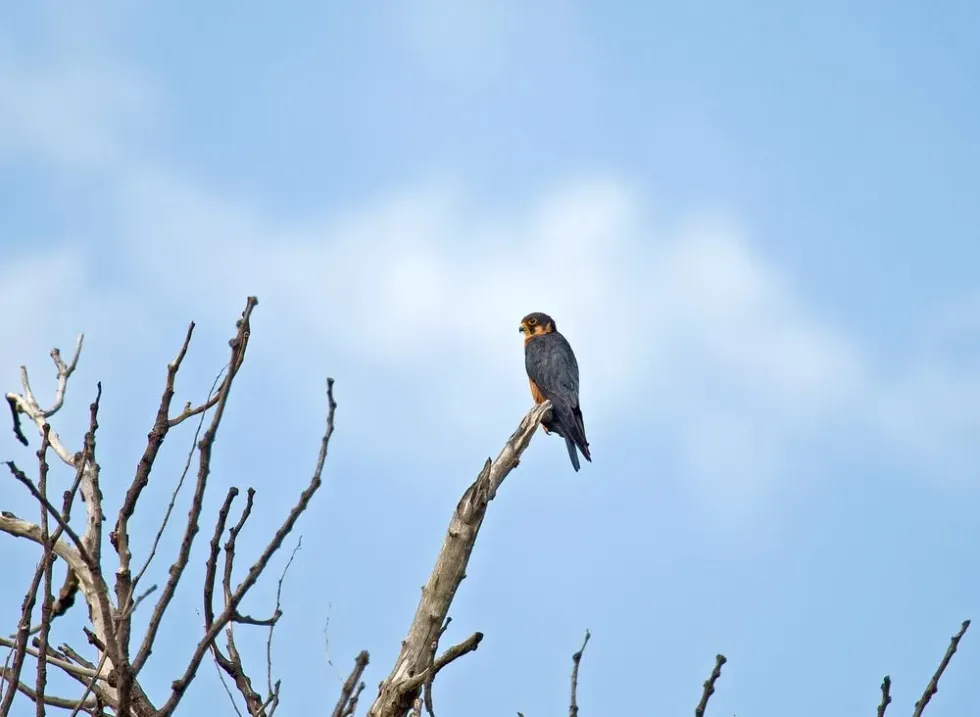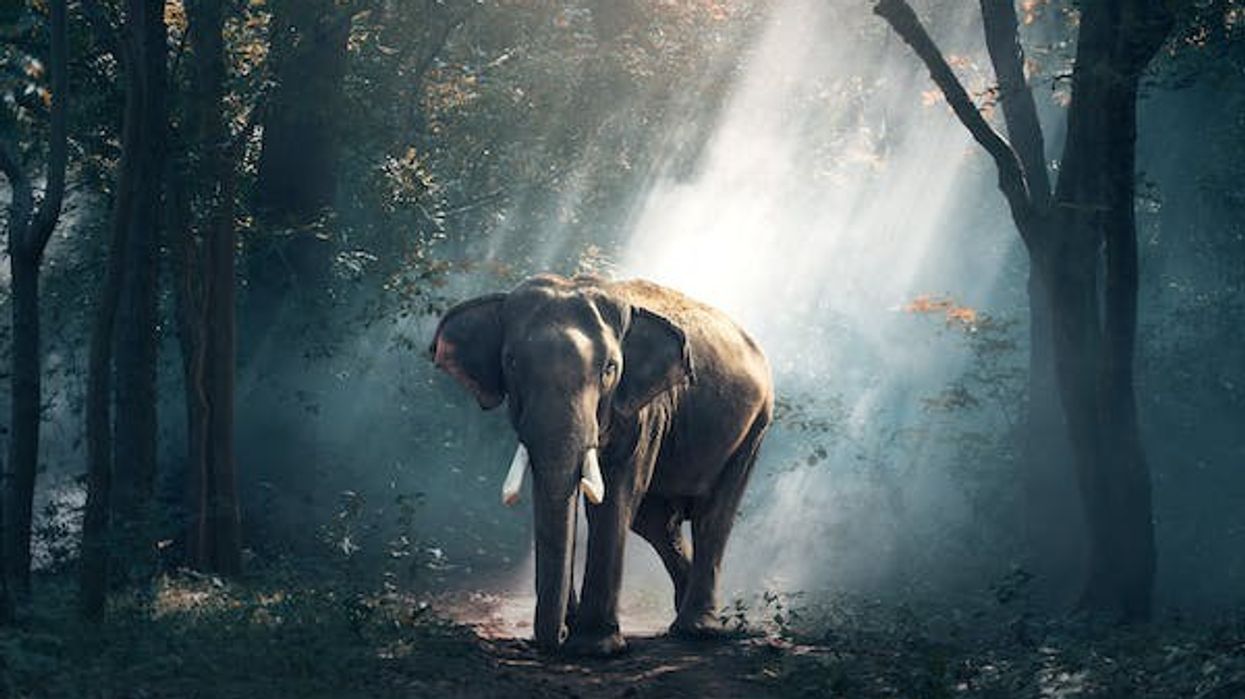The African hobby (Falco cuvierii) is a very small species of phylum Chordata, order Falconiformes, family Falconidae, and subfamily Falconinae. This bird is a monotypic species.
They have been considered as a member of the subgenus Hypotriorchis because of their similarities with other hobbies. They are a dark, medium-sized falcon with blue-gray back and black color head and yellow skin.
They are fast fliers and are mostly active during dawn. They can commonly be seen in many countries of Africa like Burundi, Namibia, Zambia, and Nigeria. This bird prefers to breed in the regions of open country near woodland and forests.
Currently, they are losing trees to deforestation and climate change. They can be called insectivores as the major portion of their diet is insects like grasshoppers, beetles, locusts, cicadas, and termites.
They even eat small birds during their breeding season. They have two identical species of Tiata falcon and the common Eurasian hobby (Subbuteo) that are also seen in Africa.
Have an interest in birds and want to know about more of them? Here you can know some amazing facts about flamingo and gray catbird.
African Hobby Interesting Facts
What type of animal is an African hobby?
The African hobby is a very small bird belonging to eastern and central Africa. It is a little falcon with black upperparts and distinguishing rufous cheeks.
What class of animal does an African hobby belong to?
This species belongs to the Aves class, order Falconiformes, and genus Falco. Their scientific name is Falco cuvierii. They are very similar to the African hobby falcon and the oriental hobby.
How many African hobbies are there in the world?
There is no exact number of African hobbies counted so far. Right now, their population is in abundance in most countries of Africa.
Where does an African hobby live?
This is a tropical bird and has a wide distribution in a range of African countries like the Gambia, Republic of the Congo, Burkina Faso, Cameroon Burundi, Central African Republic, Botswana, Chad, the Democratic Republic of the Congo, Guinea-Bissau, Ethiopia, Ivory CoastGabon, Liberia, Ghana, Kenya, and Mali.
What is an African hobby's habitat?
The distribution of these yellow skin and dark head birds of prey of the family Falconidae can mostly be seen in the habitat of woodland, moist tree, palm savannah, and gallery forest in south and west of East Africa. Their recorded population has a status of Least Concern in Central Africa and north-eastern Africa where they are very common.
Who does the African hobby live with?
This species are primarily solitary birds and do not like to interact too much with other birds except their mating partners. While migrating in summer from Africa, you can see them in small groups of four to five birds.
How long does an African hobby live?
The lifespan of the African hobby falcon varies with changing habitats. If they are in the wild under preferable conditions, they can live up to a range of three to four years.
How do they reproduce?
Little information is available on the reproduction pattern of these birds. They show solitary behavior and can be seen with their partners most of the time.
They have various egg-laying seasons depending on the geographical location. The breeding season is either between December to April or January to February. They use one nest for many breeding seasons and usually prefer locations very high.
What is their conservation status?
The conservation status of the African hobby (Falco cuvierii) of the family Falconidae, according to the data of the IUCN Red List of the International Union for Conservation of Nature (IUCN), is Least Concern (LC). Though the range of its population is decreasing, the Red List has not described them as a Vulnerable species.
Their population range is decreasing currently and these birds are losing their natural habitat to human interventions in Africa.
African Hobby Fun Facts
What does the African hobby look like?
They are of medium-size range falcons with deep rufous underparts, nape, and throat. Their back is bluish-gray in color and you can see a dark black streak on their neck if you go very close to them, but that might scare them!
Their skin is yellow and so are their feet. They are of the family Falconidae. The juvenile has broad streaks and has a darker shade of brown upperparts and pale cheeks, throat, and nape.
How cute are they?
These birds are very small little creatures with adorable fluffy plumage. Yes, they can be called cute birds.
How do they communicate?
There is not much information available on the communication of this dark species of birds. A similar species of falcon has different types of calls like food calls, alarm calls, and group calls. They use their body language as well to interact. You can tell by looking at their posture whether they are aggressive.
How big is an African hobby?
These common woodland birds of South Africa are 7.9 in (20 cm) long. One of the other good fliers and fierce, deadly birds of the same class Aves, the harpy eagle, is five times the length of this small size bird.
How fast can an African hobby fly?
These birds are blessed with good flight and can even surpass the swifts. They have an amazing speed range of 100 mph (160 kph).
How much does an African hobby weigh?
The average African hobby size is not much. The recorded weight of this small bird of the woodland of Africa is somewhere around 4.4-6.2 oz (125-178 g).
Another falcon of the same class Aves, the white gyrfalcon, weighs eight to nine times more than this bird. These birds are small or medium-size but do not possess much power to counter any predator.
What are the male and female names of the species?
There are no specific names given to the males and females of this species.
What would you call a baby African hobby?
There is no special name given to a baby of this species of the Falconidae family.
What do they eat?
The African hobby falcon is a carnivore and eats small birds and insects. Grasshoppers, caterpillars, flying insects, locusts, beetles, cicadas, and worms are their standard diet.
Are they dangerous?
These birds do not pose much danger to human beings because they are too small unless they are threatened in their habitat. Even though they are small falcons, they do have an aggressive side to them as well and you can get hurt by their beaks if you disturb them.
Would they make a good pet?
The birds of the genus falcon are not very friendly birds. They consider humans as a threat and might fly away. You have to train them before keeping them as a pet. They are birds of prey and need vast space to fly, so they may not show signs of adjustment to being in your house as a pet.
Did you know...
These birds are not majorly migratory birds, but during summer, they move to England, mainly Wales and southern Scotland.
Is a hobby a falcon?
Yes, hobby birds are called falcons. They are very swift falcons with narrow but long wings. The other three species of hobby birds are called falcons as well. They look very similar and are excellent aerialists.
What is the difference between a kestrel and a hobby?
Both the kestrel and hobby are different species of birds of prey. They have a major difference in their eating behavior especially, and the kestrel mostly spends its time resting at the roadside hovering.
This is how they catch their prey. The Hobby does not hover to catch the prey. They continuously move and catch what comes their way like lizards, dragonflies, and other small birds using their open beak.
If there is a larger prey, they use their talons to catch it and then transfer it into their mouths. They fly high and so you can the pairs feeding each other in the air.
Hobbies are birds of Africa and they rarely move except in summers. These birds cannot be seen in North American countries, but the kestrel which is a similar-looking bird is very common in North America and South America and spends most of the time of the year there.
They both have almost the same size, weight, and characteristics, but hobbies are different in terms of their long rakish wing and short tails.
Here at Kidadl, we have carefully created lots of interesting family-friendly animal facts for everyone to discover! For more relatable content, check out these saker falcon facts and prairie falcon facts for kids.
You can even occupy yourself at home by coloring in one of our free printable African hobby coloring pages.









